
I stopped writing about every record I buy—okay, stopped attempting to write about every record I buy—a few years ago. Reasons abound: I was buying too many records to keep up; an OCD trigger in my brain wanted me to post them in chronological purchase order, even though I wrote about them semi-randomly; I figured few people cared to read about dusty Wire-related records or obscure ’90s math-rock singles; I wanted to spend time writing about more recent releases from artists needing support right now. In short, I did what I’m best at—come up with reasons not to do something.
In hindsight, the true value of this practice was not allowing myself to pick my spots, which, as proven by my incredibly sporadic writing, is something I can do to the extreme. Covering a broader range of reactions than “Hey, this album is fantastic, here’s why” engaged me—I could go off on tangents more freely, and even occasionally make a point, whether it was about that particular record or not.
To that end, my desire to write about this Rex / Songs: Ohia split single (a February pick-up from Chicago’s Reckless Records) isn’t based in a need to comment on these two songs. I can do that, too: Rex’s “Untitled” was the final breath of the slow-core/alt-country act, with only singer/guitarist Curtis Harvey remaining from the group’s usual line-up. He’s backed here by mercenary violinist Joan Wasser (Dambuilders, Mind Science of the Mind, Joan as Policewoman, Those Bastard Souls, etc.) and Josh Mattews. It’s a pleasant, if not particularly memorable coda to the three LPs, one EP, and two singles that preceded it. I’d rather put on the gut-wrenching “Nothing Is Most Honorable Than You” from their self-titled debut or anything from their 1996 sophomore LP C, but my completist urges are satiated by hearing their last song. The flip features an alternate version of “How to Be Perfect Men” from Songs: Ohia’s 1999 LP Axxess & Ace, a more ragged rendition that likely holds the same completist appeal to Jason Molina fans as “Untitled” does to Rex fans.
The Songs: Ohia side of this single exemplifies a statement I’ve found myself saying a lot lately: “I never got into them.” I don’t use that phrase dismissively; I pick my spots as a listener, too, and sometimes I miss the natural opening for a record to enter my collection. I can remember two distinct opportunities in this instance: first, Epitonic provided “Captain Badass” and “Lioness” back when free MP3s were a rare commodity; second, I vaguely recall seeing Magnolia Electric Company at the Intonation Festival (the precursor to the Pitchfork Music Festival) in 2005. Neither instance prompted further exploration.
It’s plausible that I would have gotten into Songs: Ohia from “How to Be Perfect Men (Version)” alone, provided that I didn’t file the vinyl into the deep recesses of one of my shoeboxes-turned-singles-bins after a few spins. But news of Jason Molina’s recent passing placed an uncomfortable urgency on finally hearing his work. Reading the devastated reactions of Molina’s fans and friends prioritized Songs: Ohia and the Magnolia Electric Company above other acts in my listening pile. I can understand the impulse to a certain extent, since these eulogies crystallized how much his work meant to my peers, but there’s something off-putting about wanting to catch up with an artist because they’re no longer with us. That’s the impetus for me finally checking a band out? It doesn’t feel right to use a collective mourning period to determine the best entry points for an artist’s catalog.
But that’s precisely what I did. When friends posted lists of their favorite Molina records, I picked Axxess & Ace, The Lioness, and Magnolia Electric Company as gateways. It didn’t shock me that these albums resonated with me; I may not have gotten into Songs: Ohia in the previous fifteen years, but I certainly knifed through the back catalogs of stylistic kin Will Oldham and Bill Callahan during that time. I immediately felt the presence of Arab Strap members on The Lioness. If I’d found an irritating element, at least I could say “This is why it took me so long to get into these records,” but nothing stuck out. (Not that now would be the best time to say, “And you know what I found out? These records are completely overrated.”) Instead, I’m left wondering why I hadn’t done this earlier.
The best way to extract myself from this hypothetical feedback loop is to imagine the tables turning on this single. What if I’d picked it up as a Jason Molina completist with only a vague familiarity with Rex? (No offense to Rex, but I suspect that’s a more common scenario.) Without the hard stop of Molina’s death weighing on me, I would not feel the same urgency to catch up with Curtis Harvey’s music. Rex would just be another entry in the Magnet-approved, Sebastian-ignored list of 1990s indie rock.
The core truth of “I never got into them” is that “them” contains multitudes. If I made a top ten list of my most glaring musical oversights, unintentional or not, Songs: Ohia wouldn’t have made the honorable mentions. I’m equally amazed and skeptical when someone seems to have heard everything, since I don’t understand how anyone would have the time and energy for that gargantuan task. There have always been more bands, there are always more bands, there will always be more bands. All it takes is a look at Spin’s recent top 100 alternative records of the 1960s to confirm my massive blind spots. I feel guilty about not hearing Jason Molina’s music earlier, but if there’s any era of music I’m arguably too familiar with, it’s turn of the millennium independent rock. I’ll catch up on Songs: Ohia after the fact, with my listening colored by Molina’s health troubles and death, but other lacunae will only grow larger in the meantime. If I can ever hope to make significant progress, I’m going to have to pick more spots.
|

It’s been five years since Pinebender’s mammoth 2006 LP, Working Nine to Wolf. How long those years felt depends on whether your clock ticks away at Pinebender speed, a self-advertised 58 beats-per-minute. For me, it feels like decades since I saw the group decimate Great Scott in Allston. (At said show I requested, with the utmost sincerity, a four-song set list comprised of “Parade,” “Fifth and Last,” “There’s a Bag of Weights in the Back of My Car,” and “Simp Twister,” which would have filled a 45-minute slot. Baritone guitarist Stephen Howard said they’d toyed with the concept.) I’ve gotten tremendous shelf-life from the glacially paced guitar heroism of the group’s four releases, but sometime in 2009 I went into withdrawal.
Naturally I had my ear to the ground on Pinebender-related projects, checking out Howard’s solo project Quieting Syrup (Songs about a Sick Boy on Lovitt, Daytrotter session here) and guitarist/vocalist Chris Hansen’s acoustically oriented Paletazo songs on MySpace (particularly the lovely “Nothing Wrong with Love”), but news of Hansen’s Head of Skulls! slipped through my nets. That’s the high price of living too long outside of the Midwest, where I likely would have picked up The Liquid Ball EP upon its 2008 release rather than a recent trip to Reckless (which seems to be the lone place you can acquire a physical pressing of this one-side LP, although it's available digitally through the usual outlets).
For Head of Skulls!, Hansen joined up with Noah Leger, the powerhouse drummer from Hurl, Milemarker, Taking Pictures, and Thee Speaking Canaries, and bassist Allison Hollihan, formerly of Atombombpocketknife (who has since been replaced by Chicago scene veteran Pete Croke, who joins Leger and Howard in Tight Phantomz). This lineup confirms the near certainty that Head of Skulls! play faster than Pinebender, since Hansen would need to acquire one or both of Chris Brokaw and Doug Scharin to slow things down even further.
The Liquid Ball EP blasts through its first three songs in the seven minutes that would comprise the average Pinebender song. “Ghost of a Wreck” is a Hot Snakes-paced rocker, with Hansen’s barked delivery reminding me of Slint’s Tweez played at 45 RPM. (That’s in contrast to my usual comment that Pinebender sounds like a Dinosaur Jr. 45 played at 33.3.) “Gold Tooth” rifles along with garage-punk intensity until hitting its Leger-led bridge. “The Cave” seethes with a post-hardcore nastiness.
The EP’s closing track, “Winter Witch,” rewrites the script, letting the song stretch out to nearly nine minutes, but its first half is a showcase for Leger’s floor-shaking fills. The second half of the song stretches out with some familiar Pinebender chord progressions, but doom resonates with each down-stroke.
At 16:15, The Liquid Ball EP lasts only a few minutes longer than the lead track from Pinebender’s Working Nine to Wolf, but Head of Skulls! make their presence felt in that short span. For those itching for another dose, the group’s debut LP, You Became Your Mind, was finally released last year after sitting on the shelf since 2008. In hindsight, it’s a good thing I didn’t know about Head of Skulls! until now—having to wait several years instead of several weeks to hear another batch of songs would have only added to my Pinebender withdrawal.
|
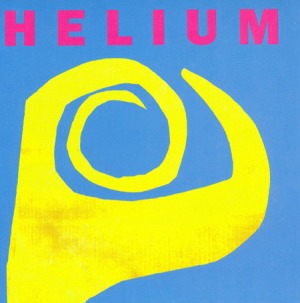
I picked up a used copy of Helium’s 7” for “Pat’s Trick” at Reckless Records and got a booby prize in the sleeve: the sales slip from the previous owner’s original purchase of the single. Along with the Helium find, the haul included two additional singles, each priced at $3.49: one from the space-rock band Flying Saucer Attack (recently recalled by Scott Tennent of Pretty Goes with Pretty) and one from Grenadine (a Simple Machines band featuring Tsunami’s Jenny Toomey and Unrest’s Mark Robinson playing 1920s-style ballads). Sadly, the slip didn’t include any further details, like the store name, the specific singles purchased, the date of sale, or the physical singles for Flying Saucer Attack and Grenadine, so my walk down someone else’s memory lane is cut short.
If you need a refresher on Helium, here goes: Washington, DC expatriate Mary Timony trekked up to Boston for college, leaving behind Dischord’s Autoclave, and replaced Mary Lou Lord in the fledging Helium. I can’t imagine Helium without Timony’s vocals, which alternate between airy wisps and husky monotones, let alone the medieval melodies of her guitar work and the simultaneously inviting/dismissing lyrics. They released two full-lengths, 1995’s fuzzed-out The Dirt of Luck and 1997’s prog-rock-inclined The Magic City, which rank among my favorite Matador Records releases, along with a few essential EPs (Pirate Prude, No Guitars, and the CD5 Superball+, which offers the superb “What Institution Are You From?” [live video link!]). Polvo’s Ash Bowie (Timony’s then-boyfriend) joined the group on bass prior to The Dirt of Luck, and there’s some bleed-through from that group’s off-kilter melodic approach. Helium split up following The Magic City, leaving Timony to an excellent solo career and now Wild Flag, but as you can tell from my purchase of a seventeen-year-old single (cue depression), the original documents hold up.
A-side “Pat’s Trick” is the lead track from The Dirt of Luck, and an excellent intro to the record’s strengths. It made an appearance on Beavis & Butthead, on which the guys commented on double-meanings and the small size of Timony’s nostrils, following up a showing of Helium’s “XXX” video which provided an ample dosage of zingers (“Hey Butthead, I think the TV’s on slow,” “I think this chick just, like, woke up or something,” “She probably doesn’t really start rocking until later,” “Check it out her guitar’s broken”).
The flip side offers the aptly titled “Ghost Car,” a haunting piano ballad muses how “What I’ve got can make you stop this ride to hell so I can get off” and closes with a muted warning to “Stop this car before it goes too far.” It’s an intriguing diversion, but fits better as a b-side than a missing piece of The Dirt of Luck.
From what I can tell, Helium’s b-sides aren’t available digitally, so I can pass along this compilation of b-sides and non-album tracks with more excitement than guilt. Highlights include early single “Lucy” (which appeared on the bonus disc of What’s Up Matador), an alternate take of “Superball” with Joan Wasser from the Dambuilders (who also joined Timony in Mind Science of the Mind, a short-lived side band fronted by Nathan Larson of Shudder to Think), and the aforementioned “What Institution Are You From.” Godspeed to the Soulseek user who initially compiled this material.
|
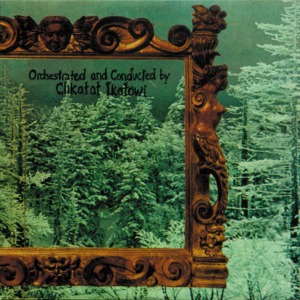
I’d never heard of Clikatat Ikatowi before last year, when I was formally introduced to the group by my friend Charlie. There is an underlying logic to both sides of that sentence. Charlie grew up as a San Diego punk rock kid, so the importance and visibility of an art-punk group like Clikatat Ikatowi was exponentially greater there. In contrast, my knowledge of the ’90s San Diego scene emphasizes the bigger names and more palatable sounds of Drive Like Jehu, Rocket from the Crypt, and Heavy Vegetable, overlooking the more explicitly hardcore realm of Gravity Records. At the very least, I’d be able to pick names like Heroin, Mohinder, Indian Summer, and Antioch Arrow out of a line-up. But Clikatat Ikatowi? Even after typing their name three times in this paragraph I'm unsure about the correct spelling.
Charlie was right to recommend Clikatat Ikatowi to me, however, and I was smart to snare a copy of their 1996 debut LP Orchestrated and Conducted by Clikatat Ikatowi at Mystery Train. There’s no doubt this band came from the ’90s San Diego scene (with a member of Heroin, no less), but for every passage of caterwauling screamo, there’s a confident lull closer to the quieter moments of Jehu, Slint, June of 44, or Rodan. Drummer Mario Rubalcaba, later of Thingy, Hot Snakes, Rocket from the Crypt, Black Heart Procession, and Earthless, is an absolute beast, levitating the frayed electrical wires coming from the guitars and vocals and preventing the whole apparatus from short-circuiting. There are ample doses of math-rock here, but unlike the rehearsed confidence of the recently reviewed Rockets Red Glare, those time changes often hit at breakneck speed. Keep your arms and legs inside the vehicle at all times.
Those moments of June of 44-ness (minus the nautical fetish) represent an unpredictability that keeps the album slippery even after a few spins. Two songs, “Desert Oasis” and “Transmission” (.mp3), stretch out past five minutes, while others pass out before hitting two minutes. Some songs are delivered with throat-killing screams, others pick up Slint’s mumbled speech. Sometimes the guitars throw notes at a dartboard, other times the riffs congeal into fist-pumping classics. Even after you’ve recognized the patterns, their execution betrays normal order. Hell, there’s harmonica in the middle of “Desert Oasis.”
Clikatat Ikatowi’s limited discography offers a manageable addition to your to-buy list. Along with Orchestrated, they released the eight-song 1998 LP River of Souls and a live album, Live August 29th and 30th, 1995 on Gravity Records. Given that member Ryan Noel (later of A.R.E. Weapons) died of a heroin overdose in 2004, reunion shows are out of the question, but fortunately, their records hold up without the context of a sweaty, all-ages punk venue.
|
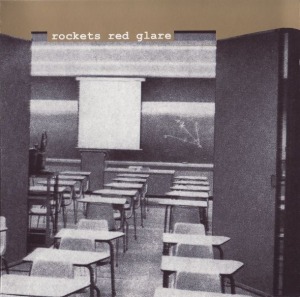
This past weekend I came across a copy of Rockets Red Glare’s 2002 self-titled debut at Mystery Train Records in Gloucester, MA (otherwise known as my favorite record store in the northeast). I would be surprised by the score if not for its source; I’ve found all sorts of “This shouldn’t be here…” sundries at Mystery Train, including a stack of mid-’90s Midwestern rock records that I never caught a glimpse of during my six years living in the Midwest. Finding a limited-run vinyl copy of a Toronto post-hardcore outfit’s debut record is strange, but not unforeseen. Actually buying it, that was the tricky part.
(Choose your own adventure directions: Skip down two paragraphs for an description of this record and a sample mp3. Keep going for record-buying anecdotes.)
I can’t remember if this habit pre-dated the dollar LP warehouse, but my process for record shopping is to pull everything of interest and then sort through it at the end. I make three piles: things I’ll definitely buy, things I’ll check reviews (or Discogs prices) on, and things I’ll stop kidding myself on and put back. During this trip to Mystery Train, the first pile was comprised of Dr. Octagon’s Dr. Octagonecologyst (an album I begrudgingly bought on CD a few years ago but will gladly purchase in my preferred format), Clikatat Ikatowi’s Orchestrated and Performed by Clikatat Ikatowi (a recommendation from my friend Charlie—San Diego math-rock/ with drummer Mario Rubalcaba, later of Thingy, Rocket from the Crypt, Hot Snakes, and Earthless), and M83’s Teen Angst EP (cheap, great song, bonus b-side and remix). The second pile was towering: a pair of John Coltrane records ( Olé Coltrane and Live at Birdland) that became no-brainers; a Sun Ra’s Live at Montreux (which reinforced my issue with Sun Ra—I have no idea where to go next); a Jon Hassell LP (Fourth World Volume Two: Dream Theory in Malaya) that reminded me I need to spend more time with the copy of Fourth World Volume One: Possible Musics I grabbed in a previous visit to Mystery Train; a Beastie Boys seven-inch for “Sure Shot” that triggered my potential resale reflex; and the Rockets Red Glare LP. The “C’mon, you have places to be” pile included a pristine copy of the Rolling Stones’ Their Satanic Majesties Request; an Engine Down single; and Pinback off-shoot The Ladies’ lone LP, They Mean Us. With regard to Engine Down and Rob Crow-related albums, Enuff Z’nuff, you know?
I narrowed my stack down to the Dr. Octagon, Clikatat Ikatowi, M83, Beastie Boys and Coltrane records. The big question mark was the Rockets Red Glare album. The review touchstones were tempting—Hoover, Slint, Shellac, Mission of Burma, ’90s math-rock like Sweep the Leg Johnny (whose label Sick Room Records released the CD pressing of this album)—but I was sure I’d seen it there before and was relatively confident I would see it there again. Ultimately I flipped a mental coin, saw that it landed on “Just buy the damn thing,” and checked out.
That was a wise decision. Despite possessing a band name more evocative of super-patriotic American country music, Rockets Red Glare nails Hoover’s style of churning post-hardcore. The average track length stretches to seven minutes, but there’s no excess. The tangled guitars, clear bass lines, deftly shifting drums, and alternately spoken and shouted vocals adhere tightly without an ounce of studio trickery. If you enjoy harmonics cutting through a thick haze of crash cymbals, shouted vocals offering impenetrable poetry (from “Embouchure”: “History is our lemon yellow awning / Opposite spokes obviate sorrow”), stop-starts that have been practiced into muscle memory, quiet passages with wandering arpeggios, and urgent strafing in the place of big choruses, Rockets Red Glare is an obvious pick-up. I have a stack of promo CDs from the late ’90s that evoke this sound, but few of them came close to Rockets Red Glare’s brutal efficiency. (Higher praise: I'm far more likely to put this one on than post-Hoover project Regulator Watts' The Aesthetic of No-Drag.) Check out “Union Station” (.mp3), which is one of the album’s standout tracks.

Rockets Red Glare released one more album, 2003’s Moonlight Desires, also on the Montreal-based Blue Skies Turn Black label, before going their separate ways. Singer/guitarist Evan Clarke drummed for Toronto slow-core outfit Picastro for a spell and joined up with Burn Rome in a Dream, while bassist Jeremy Strachan and drummer David Weinkauf formed the free-jazz outfit Feuermusik (saxophone and bucket percussion). The group played a few reunion shows in 2009, but didn’t release anything new. I haven’t checked out Moonlight Desires yet, so I can’t vouch for its post-hardcore goodness, but if you find yourself in front of a copy of Rockets Red Glare, move it into the to-buy pile.
Bonus content alert: Commenter Anthony below mentioned that Rockets Red Glare's first single, "Redshift" b/w "Halifax," contains his favorite song from the group. Since that single appears to be highly out-of-print, here it is: "Redshift" b/w "Halifax" (.mp3). The a-side is an instrumental, the b-side is an urgent rocker. Both songs are more compact than their sprawling companions on Rockets Red Glare. This single reminds me of another excellent, mostly forgotten math-rock band: Drill for Absentee.
|
Like Pioneers – Piecemeal MP3s – Abandoned Love, 2010

There’s a specific aspect regarding The Narrator’s 2008 break-up that made it more painful than, say, Shiner’s 2003 break-up. Unlike Shiner’s Allen Epley, who resurfaced quickly with The Life and Times, the two frontmen of The Narrator weren’t just giving up on that band, they were giving up on that lifestyle. It came out explicitly in their final song, “So the End” (a MySpace exclusive) in which Sam Axelrod wearily relayed “We’re broke and we’re spent and it’s starting to take its toll” and “The time has come to find a new home” before culminating in a sing-along of “I can’t live on this witch’s salary.” It essentially said, “We may play music again, but our time in a back-breaking touring band is over.” As a fan of said back-breaking touring band, it was a real bummer.
Axelrod moved into the supporting role in at least one band, playing bass in The End of the World, but The Narrator’s other guitarist/singer, Jesse Woghin, was eerily quiet. This extended to the Chicago-based Flameshovel Records, which Woghin helped form and run. In addition to housing The Narrator and other Chicago acts like Chin Up Chin Up, Bound Stems, The Race, and Mannequin Men, Flameshovel expanded its geographic scope with excellent albums from Maritime, Judah Johnson, and Lukestar. It’s been over a year since Mannequin Men’s Use Your Illusion, Too came out, which seems to have signaled the end of a fine label. I suspect that having The Narrator, Chin Up Chin Up, and Bound Stems all break up in 2008 and 2009 sapped a great deal of the friend-driven enthusiasm from Woghin and company.
Like Pioneers’ Piecemeal aims to revive that enthusiasm without carrying its baggage. The group—80% of Bound Stems, Woghin from The Narrator, drummer Matt Holland, and multi-instrumentalist Darren Garvey—started last year with a no-pressure weekend trip to IV Lab Studios in Chicago, where they cranked out ten songs for Piecemeal. (“Paloma” is a late-arriving Bandcamp bonus track.) They’ve played a few shows in Chicago, with the line-up varying with availability, but don’t expect a US-wide tour any time soon. That lifestyle is over, but fortunately the music remains.
Piecemeal could have easily come across as just that—a hodge-podge of styles, vocalists, and energies that never quite congeals. But Like Pioneers find consistency in the proceedings even as those elements push and pull, letting the guitar-centric indie rock of Woghin’s “Crop Circles Plus Legs” coexist with the lonely pump organ of Bobby Gallivan’s “Teakettles No. 1,” situating the polished indie pop of “English Garden” next to the guitar-dueling outro of “Gift from a Holiday,” and bookending the album with the blurred guitar and organ melodies of evocative opener “Some People” and the affecting piano balladry of “Crab Candy.” This range comes hand-in-hand with being a loose collective, since there’s less of a need to get everyone involved in every track, tailor songs for the live settings, or meet expectations.
Like Pioneers’ Piecemeal is a great reminder of what Bound Stems, The Narrator, and Flameshovel had to offer, even as it abandons the trappings of being in those touring bands and running that label. My concern is that those trappings are precisely what led me to this new group in the first place. You won’t find the digital-only release of Piecemeal in your local record store or see Like Pioneers on tour. All I can hope is that people continue to stumble onto Like Pioneers (and The Narrator, Bound Stems, and Chin Up Chin Up), encouraging them to keep making this memorable blend of energetic indie rock and melodic, evocative indie pop.
|
Tre Orsi – Devices + Emblems LP – Comedy Minus One, 2010
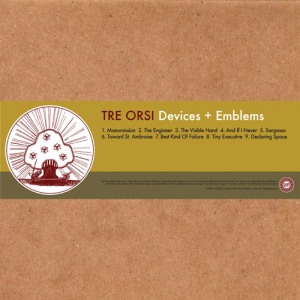
It’s both easy and dangerous to go overboard on the relevance of a group’s influences or reference points (whether acknowledged or perceived), but Tre Orsi’s relationship with Silkworm and Bedhead explains what makes them a compelling band on their own accord. The bullet points of this relationship are clear. Tre Orsi’s first released song was a bravado cover of Silkworm’s “Insomnia” for the 2006 tribute album An Idiot To Not Appreciate Your Time: The Songs of Silkworm, which re-imagined Andy Cohen’s buzzing guitar work as restrained piano. Tre Orsi’s Matthew Barnhart helped record The New Year’s last two albums, a favor which Bubba Kadane returned by producing Devices + Emblems. Barnhart’s done live sound and tour management for both groups. Few recent bands can claim such a symbiotic relationship with their touchstones. It puts Tre Orsi in the unique position of being the descendents of Silkworm and Bedhead and the peers of Bottomless Pit and The New Year.
But does Tre Orsi sound like Silkworm and Bedhead? In a general indie rock sense, sure. Like Silkworm and countless other bands, they have a guitar/bass/drums line-up with an emphasis on replicating their live sound. Vocally, Barnhart can occasionally be mistaken for the lost third Kadane brother, but his band is two guitarists short of Bedhead’s clean, three guitar arrangements. What Tre Orsi picks up from those groups is an emphasis on honest, carefully crafted songwriting that forgoes fashionable, fleeting trends in favor of lasting impact. Granted, the sexiness of now is more immediately satisfying, which led me to sit on particular Silkworm recordings and most of Bedhead’s catalog until the light went on in my head and made wonder how I’d ever not counted Firewater as one of my personal favorites or spent more time with Transaction de Novo. Needless to say, this object lesson in patient listening comes a lot easier for me at 30 than it did at 17.
My immediate reaction to Tre Orsi’s Devices + Emblems was informed by these experiences. The first time I heard it, I wasn’t blown away, but I knew there was something I enjoyed that would continue to grow, so I kept coming back. Every time I’ve listened to it since (especially my first spin of the LP), Devices + Emblems has gotten better. It’s now in regular driving rotation, which is the mark of a strong, long-lasting rock album. Getting to that point shouldn’t happen immediately for an album loaded with enjoyable left-turns. You need to figure out where those turns take you first. Clear starting point “The Engineer” (which previously appeared on Gerard Cosloy’s labor-of-love compilation of Austin-area bands, Casual Victim Pile: Austin 2010) winds its way through a windmill guitar and air-drum friendly intro, a nicely cresting verse, a cathartic pre-chorus (“I hate all these thoughts / I composed in foreign language”), a charging, energetic chorus (“I give to you / Philosophy / Before I die / Right here, stateside”), a ragged solo, and finally a reflective outro that revisits the previous lyrics. I had to understand this topography before I could sing along and air drum as I speed down 93 to the city, but that’s an enjoyable process on its own accord. Other highlights include the stomping drums and buzzing arpeggios of “Toward St. Ambrose,” the head-bobbing chorus of “Tiny Executives,” and the distorted squeals of “Best Kind of Failure,” but there isn’t a disappointing track in the lot.
True to the no-bullshit ethos that runs through every note of Tre Orsi’s music, Devices + Emblems is a tidy nine songs, twenty-seven minutes. Every time the final notes of “Declaring Space” close out the record, I hope a few more songs magically appear, but I’m limited to the equally excellent “The Illustrator” b/w “Faulkner’s Blues” single and that “Insomnia” cover. Now my edict for patience becomes doubly important, since music as carefully crafted as Tre Orsi’s doesn’t write itself overnight, so their now anxiously awaited second album may be a few years away. It’s here where I’d like them to be more Silkworm/Bottomless Pit and less Bedhead/The New Year.
|
Shipping News – One Less Heartless to Fear LP – Karate Body, 2010
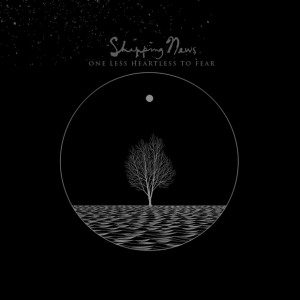
Shipping News’ One Less Heartless to Fear might fool you. If you didn’t know this album was sourced from two live performances (Louisville in 2009, Tokyo in 2006), recognize the two tracks from 2005’s Flies the Fields, or hear the occasional crowd noise, you might initially assume that One Less Heartless to Fear is the product of a flourish-free Bob Weston recording session. Instead it’s a live album of primarily new material, a unique proposition which pays off in spades. That this decision was made out of necessity—Jason Noble’s cancer treatment prevented an elongated studio session—doesn’t detract from its success: One Less Heartless to Fear couples Noble and Mueller’s trademark knotty riffage and elliptical lyrics with a welcome dose of immediacy courtesy of its live setting.
Looking back at their catalog, immediacy has never been Shipping News’ foremost strength. Their 1997 debut LP, Save Everything, marked the highly anticipated reunion of Rodan’s two singer/guitarists (even though Noble played bass until Flies the Fields), but its germination as background music for NPR’s This American Life predicts the album’s penchant for swaying instrumental passages. I appreciate the moody textures of “A True Lover’s Knot,” “All by Electricity,” and “Steerage” quite a bit now, but if you come to the album expecting for the aggressive dynamics of Rodan’s “Everyday World of Bodies” (live video alert) like I did back in 1998, it’ll leave you scratching your head. 2001’s Very Soon, and in Pleasant Company reigns as their most consistent record, but its highlights are introspective slow-burners “Actual Blood,” “Quiet Victories,” “Contents of a Landfill,” and “How to Draw Horses” (the last a marvelous companion piece to Rodan’s “Bible Silver Corner”) not the requisite math-rock instrumental “Nine Bodies, Nine States.” A series of experimental EPs under the RMSN tag (subsequently collected in the Three/Four LP along with a few new tracks) explored unfamiliar terrain, but putting the ghostly visions of “Haunted on Foot,” the throbbing bass of drone-rockers “Paper Lanterns” and “We Start to Drift,” the weary balladry of “Sickening Bridge Versus Horrible Bed,” and the coiled aggression of “You Can’t Hide the Mark Inside” on a single map is a tall order. Flies the Field regains that cohesion by reining in the scope, but in turn loses the spontaneity of Three/Four’s smorgasbord. I ultimately came around to hear each of these releases on its own terms, but in every instance, it took time.
This history is precisely what makes One Less Heartless to Fear such a thrill; it’s not an album that requires months to gestate. With the tight, Shellac-ian rhythms that open “Antebellum,” Shipping News announce that they’re not here to fuck around. Jason Noble’s ragged barks of “Is your heart a frozen river? / Is your heart a frozen lake?” supplies “This Is Not an Exit” with a heavy dose of gravity, but the uncharacteristic humor of “We’ve got cornea scans / E-mail scams / Root Beer Tuesday / Hot Fudge Thursday / Thank God it’s Thursday” cuts that tension in smile-inducing, fist-pumping fashion. The bloodied-knuckled chant of “Calm down!” in Flies the Fields holdover “(Morays or) Demon” fits One Less Heartless to Fear’s up-front nature perfectly. Rave-up rocker “The Delicate” chews on repetition like “She can hear the birds living in the leaves with their fucked up fucked up language” with demonic glee. When Heartless downshifts with the moody instrumental “Half a House,” the tensely introspective “7s,” and Jeff Mueller’s thousand-yard stare on Flies the Fields’s “Axons and Dendrites,” it feels earned, necessary. The balance between blunt force, instrumental dexterity, and haunting memories is spot-on.
Who knows if Shipping News would’ve carried the fervor from their live sets into the recording studio regardless of the scenario, but One Less Heartless to Fear benefits exponentially from its constraints. It exhibits Shipping News as a well-oiled live band with inspired new material and cuts the fat away. For the first time in their history, I can’t ask for more.
Given Jason Noble’s aforementioned battle with cancer (which you can read about in his Caring Bridge journal or this affecting article from his recent stint as a guest editor for Magnet), it would be easy and understandable to plug this album on that basis alone, but the fact that it downright slays removes any sense of charity. (I'm doing you a favor, not Noble.) I probably don’t need to remind you that Noble’s been responsible for a slew of wonderful albums from Shipping News, Rodan, Rachel’s, and other side projects. So if you’re interested in One Less Heartless to Fear, pony up the money for the download, CD, or LP, drop $2 to the Red Cross relief efforts in Pakistan and get the non-album single "Take a Deep Breath," pick up the Young Scamels album (a Rachel’s offshoot that scored a Louisville performance of The Tempest), buy a Shipping News, Rodan, or Endpoint shirt with profits going to Noble’s care, or at the very least, send the man some goodwill. Things seem to be looking up for him lately, which is a huge sigh of relief for both his physical well-being and my hopes that he continues making music as memorable as One Less Heartless to Fear.
|
Bottomless Pit – Blood Under the Bridge 2LP+CD – Comedy Minus One, 2010 – $20

I decided to go two routes with this review for an obvious reason. The second route is really long.
The short version: Bottomless Pit adds to their flawless track record with another superb release. Expanding on the surging melodies of the 2008 Congress EP, Blood Under the Bridge returns to straightforward Silkworm-esque rock in “Summerwind,” “Late,” and “Is It a Ditch,” explores mellow ground on “Rhinelander” and “Q.E.D.,” and closes with a searing Andy Cohen solo in the towering “38 Souls.” Book this album for the highest reaches of my year-end list, mirroring the positions of Hammer of the Gods and Congress.
The long version: Bottomless Pit is an incomparably personal band. Each release reflects upon the key fact of the group’s existence: without the reckless vehicular homicide that took the life of Michael Dahlquist, Tim Midgett and Andy Cohen would still be releasing new Silkworm albums every two years. Instead they chose to forge ahead with a new outfit, swapping Midgett’s sharp, expressive bass lines and Dahlquist’s thunderous kick drum for Midgett’s new baritone guitar, bassist Brian Orchard’s deep, minimal lines, and former Seam drummer Chris Manfrin’s dexterity and precision. The change in rhythm section character would speak volumes if Midgett and Cohen didn’t actively address Dahlquist’s passing in their lyrics. Midgett is often hauntingly direct: “When you get it in your mind to live again” from “The Cardinal Movements,” “You were a king when you knew what you were worth” from “Human Out of Me,” “People are frightening / When they don’t got a reason to live” in “Pitch.” Cohen opts for veiled storytelling, contributing “Dead Man’s Blues” to Hammer of the Gods and noting how “Nothing is sadder than chasing a ghost” in “Fish Eyes.” Both approaches are gut-punches.
Yet to listening to Bottomless Pit in the sole context of Michael Dahlquist’s death ignores the universality of their lyrical themes. Similar to how Fugazi succeeds at making politically charged rock by avoiding explicit details, Bottomless Pit adds an abstracted level of catharsis to accompany the autobiographical reading. Is a specific song—the astounding “Leave the Light On” from Hammer of the Gods, for example—about Dahlquist, Midgett’s mindset, or just a general feeling? To my ears, all three are present. This ability to translate personal experience into commentary on the human condition is all too rare.

It’s not as if Silkworm lacked this capacity. Midgett’s “Xian Undertaker” from It’ll Be Cool stares death in the face and offers a knowing smirk. Cohen’s “Don’t Make Plans This Friday” from Firewater captures moments of fleeting brilliance in suffocating discontent. I could go on and on. (Seriously: Go get Firewater, Lifestyle, It’ll Be Cool, and Libertine. For starters.) The difference is that Bottomless Pit’s album-to-album development is intertwined with a sense of personal progression that acts as a frame of reference for each song, each album. When the regret and subcutaneous tension of Hammer of the Gods blossomed into the resiliency of Congress, I felt both a profound sense of optimism from the songs (especially “Red Pen”) and a strange pang of relief that Tim Midgett was less consumed by grief within them. This developmental arc points in multiple, often divergent paths on Blood Under the Bridge, which prevents me from coming up with a single-line summary for how it shifts from the thematic base of Congress. That makes Blood harder to nail down, but by no means diminishes the returns.
The first two songs are deceptively nonchalant, starting with the feel-good rhythm and intertwined guitar melodies of the seven-minute-long “Winterwind.” Tim Midgett’s lyrics encourage a fresh start: “Waiting on deliverance is just like waiting on a tree / That you can’t get out from under / Get out from under it now.” A familiar riff trickles in during the song’s lengthy outro: a guitar part from Silkworm’s “Bar Ice.” It still throws me for a loop, a glance back at the past even as the lyrics encourage a step away. You still get that step away with the mellow introspection of the percussion-free “Rhinelander.” Midgett’s line that “There’s no such thing as too much time” makes me long for more time with the idyllic guitar interplay, not regret missed opportunities or time wasted.
Andy Cohen’s “Summerwind” breaks the calm by spinning the elliptical refrain “It’s not nothing I would do again” over jagged chords. “We lost it all and started fresh” stands out from the hypothetical lyric sheet (although “I saw the devil on a commuter train” is classic Cohen), applying just as easily to a failed romantic relationship as his old band. The up-tempo swing continues with “Late,” a brisk rocker that pulls Midgett out of distanced contemplation with a downright angry chorus of “So many fuckers in this world / To line up / And trade for you.” The album’s middle point, “Dixon,” is a Southern rock instrumental, an enjoyable lark that wouldn’t have seemed plausible on either of Blood’s predecessors.
Blood downshifts over its next few songs. Midgett’s mid-tempo “Kiss Them All” ruminates on its refrain, “I’ve been waiting on the real you all along,” then lingers on an extended, drum-focused outro. Cohen’s “Is It a Ditch” fuels his nimble riffing with a twinge of reticence. Midgett’s “Q.E.D.” returns to the dreamy contemplation of “Rhinelander,” ambling through some heady territory with “Always shit to do / When I’m dead I will still have a list / But sometimes things just feel complete.” His wordless coos and Chris Manfrin’s intricate shuffle elevate the song from those idle thoughts.

Blood Under the Bridge closes with Cohen’s “38 Souls,” a howling storm of distorted riffs, spine-chilling vocals, and passionate soloing. The song begins as one of his darkly comic narratives—“I had collected 38 souls / Needed two more to reach my goal / What good are they anyway / Left them stacked up in the foyer”—but ratchets up the intensity with the powerful delivery of “When I woke up they were gone / I had to let them get away.” Turning that couplet into an imperative (“When I wake up they’ll be gone / I have to let them get away”) underscores the desperation in his voice. Cohen has mostly avoided his penchant for ragged, cathartic solos in Bottomless Pit, but the scorched-earth solo he plays on “38 Souls” instantly joins his highlight reel (along with “Don’t Make Plans This Friday” and “Tarnished Angel” from Firewater). “38 Souls” is a visceral, devastating assault, one Bottomless Pit was wise to put at the end of the album.
There isn’t a song on Blood Under the Bridge that I don’t enjoy, but how they fit together is less obvious than it was on Hammer of the Gods or Congress. “Dixon” felt out of place on the first few spins. “Rhinelander” and “Q.E.D.” seemed overly muted, especially in comparison with the blazing intensity of “38 Souls.” As I spent more time with the songs, the path from Congress to Blood became clearer. Blood takes firm steps in new directions, but still looks over its shoulder at the past, which appears in the recall of Silkworm’s “Bar Ice” in “Winterwind,” the fiery solo of “38 Souls,” and lyrical references to Dahlquist both oblique and explicit. The thoughts of both singers wander, but Blood starts with Midgett’s imperative (“Get out from under it now”) and ends with Cohen’s (“I have to let them get away”). “Easier said than done” is the clichéd moral, but as anyone who’s lost a loved one will attest, those memories continue to pop up at unexpected, affecting times. They will certainly pop up when listening to Blood Under the Bridge, a testament to Bottomless Pit’s foremost strength: translating their own experiences into humanistic rumination of the highest order.
If you live in Pittsburgh, Boston, New York, or Columbus, you have a chance to see Bottomless Pit this weekend on an increasingly rare outing from their home base of Chicago. I’m looking forward to catching them on Friday for the first time since an excellent 2008 show with Chris Brokaw and the Kadane Brothers. If not, you can order their three albums direct from the group or from Comedy Minus One. The vinyl pressings are about as nice as it gets—45 rpm LPs, thick gatefold sleeves for the full-lengths—and include a copy of the CD.
|
Brian Eno, et al – Music for Films III LP – Opal, 1988 – $4 (10/15 Reckless Records, Broadway Avenue)
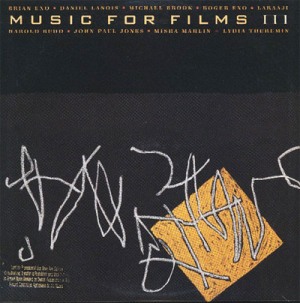
In my review of David Sheppard’s On Some Faraway Beach: The Life and Times of Brian Eno, I noted the drop in coverage depth starting in the mid 1980s. Prioritizing his output in the 1970s and early 1980s—specifically Roxy Music, No Pussyfooting, his first four solo albums, Discreet Music, the Ambient series, My Life in the Bush of Ghosts, David Bowie’s Berlin trilogy, and Talking Heads’ Fear of Music and Remain in Light—dictates that you’ll read more about albums you’ve likely heard instead of those you haven’t. This situation makes perfect sense. Those are touchstone recordings. Comparatively few people would buy a book emphasizing Eno’s generative art experiments, Nerve Net, collaboration with John Cale on Wrong Way Up, and production duties for James and Coldplay. Yet the unfamiliar terrain of Eno’s late ’80s, ’90s, and 2000s output would have benefitted from a clearer guide. Unlike the 1970s, when it seemed Eno could do no wrong, Sheppard’s speedy run-through (and occasional dismissal) of Eno’s later records indicates inconsistent and frequently unrewarding results. I cite Wrong Way Up and Nerve Net because those are the only two albums I was encouraged to track down. Certainly that can’t be it, right?
My standard “leap before you look” move would be to do a deep dive into the back nine of Eno’s catalog, to become that clear guide I wished for, but I’ve been warned by Sheppard and I will heed that warning. The only three post-1985 Eno albums I’ve heard are 1988’s Music for Films III, 2008’s Everything That Happens Will Happen Today with David Byrne, and 2010’s Small Craft on a Milk Sea with Jon Hopkins and Leo Abrahams (an album Dusted just eviscerated). A conservative estimate of true solo albums and major collaborations puts an additional twenty albums between 1988 and 2008. Yikes. If the sheer number isn’t enough to dissuade you from a deep dive, perhaps the lagging sonics of Music for Films III will do the trick.
I didn’t approach Music for Films III with high expectations. The first Music for Films volume is the rare ’70s Eno LP that underwhelms, since too many of the short, incidental pieces sound inconsequential without the foregrounds of their intended context. Its first sequel came in 1983 as part of the Working Backwards box set, but Music for Films II was mostly a dry run for the superior Apollo: Atmospheres and Soundtracks, containing a few of its tracks and introducing the trio of Brian Eno, Roger Eno, and Daniel Lanois. Music for Films III comes five years later with a change of address—Eno left the sputtering EG label and began his own Warner imprint called Opal. For Opal and Music for Films III, Eno brings in some familiar names: Daniel Lanois, Roger Eno, Harold Budd (from Ambient 2 and The Pearl), and Laraaji (the sole performer of Ambient 3). He supplements them with Michael Brook, Misha Mahlin and Lydia Theremin, and Led Zeppelin’s own John Paul Jones.
A collaboration-heavy Eno album should be no surprise, but Music for Films III is more compilation than collaboration. Of the thirteen tracks on the original vinyl pressing, Eno goes solo on two, collaborates on three, produces three, mixes one, and abstains from involvement on the final four. The results, predictably, are scattershot. Unpredictably, the Enos fare the poorest. Brian’s “Saint Tom” and “Theme from ‘Creation’” suffer from dated synth palettes. Roger’s maudlin “Quixote” would best score a scene of a daytime soap opera in which a main character is exploring a cave. The late-night piano on Roger’s “Fleeting Smile” feels too familiar. Laraaji has the biggest gap in quality, with the modulated vocals of “Zaragoza” sounding thoroughly out of place in a bad way, while the untreated thumb piano on “Kalimba” (heard in the background of “Zaragoza”) stands out with its welcome simplicity. The spooky theremin on Misha Mahlin and Lydia Theremin’s “For Her Atoms” is too identifiable as such, lending an overt ’50s sci-fi air. Harold Budd brings out his usual blurred, new age piano tricks for “Balthus Bemused” with diminishing returns.
Music for Films III isn’t a total wash. Daniel Lanois acquits himself well in his three collaborations with Brian Eno. “Tension Block” is an appropriate name for a dense, bass-driven exploration of Middle Eastern percussion. “White Mustang” is an unnerving callback to Apollo, whereas “Sirens” takes that feeling and shifts it underground. A few contributors also excel. The echoing guitar lines of Michael Brook’s “Err” could stretch out over canyons. The biggest surprise is actually John Paul Jones’ “Four-Minute Warning,” a sound collage of horns that snowballs into cacophony. Did I overlook Led Zeppelin’s free-jazz album?
Beyond the mish-mash of styles and the confounding mix of collaboration and compilation, the biggest problem with Music for Films III is its specificity. Let me explain. The original Music for Films let me down because too many of the incidental pieces weren’t immediately evocative. But for the specific purpose of making music for use in imaginary films, emphasis on the plural, that makes sense. Limiting the contexts for a given piece ultimately limits its utility, and this series is all about utility. Evoking a very particular scene, like the daytime soap opera cave exploration in Roger Eno’s “Quixote,” limits a song’s potential application. It’s not the presence of poor tracks on Music for Films III that lessens my enthusiasm for the twenty years of unexplored Eno albums, since those can be written off as failed experiments from an artist prone to experimentation. It’s the idea that the model is failing that’s truly disconcerting. If I learned anything from On Some Faraway Beach, it’s that Brian Eno loves his models.
|
|

